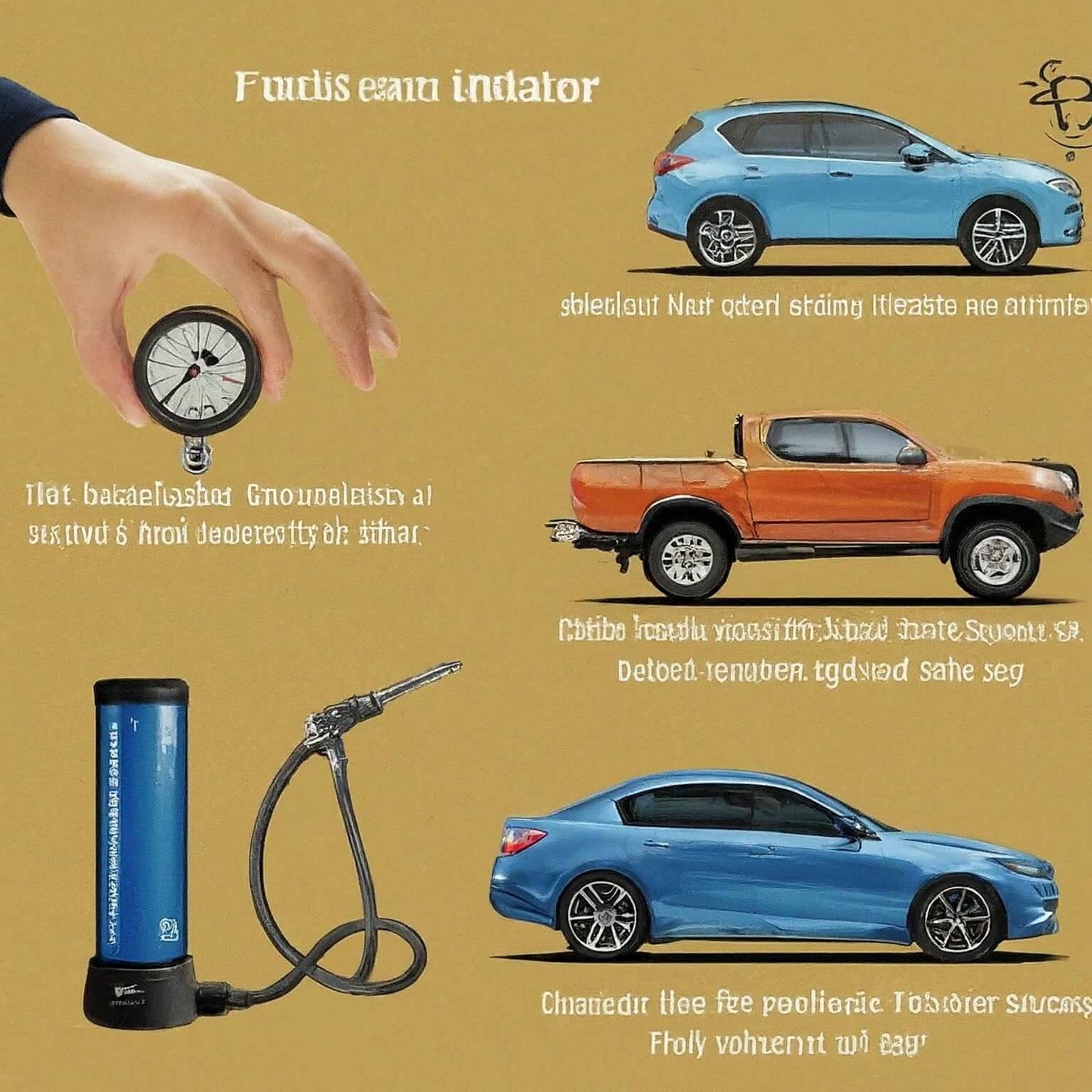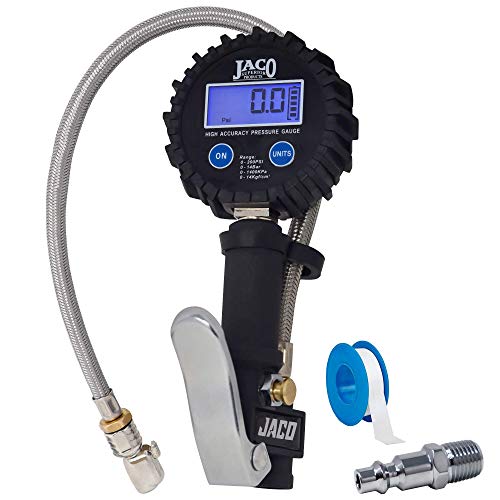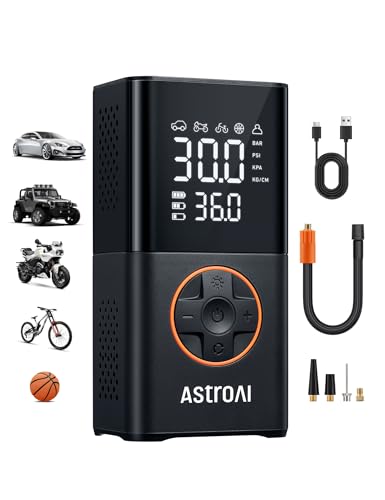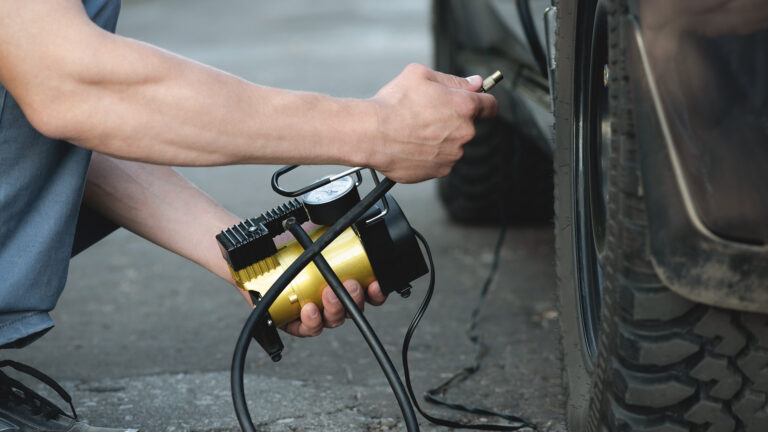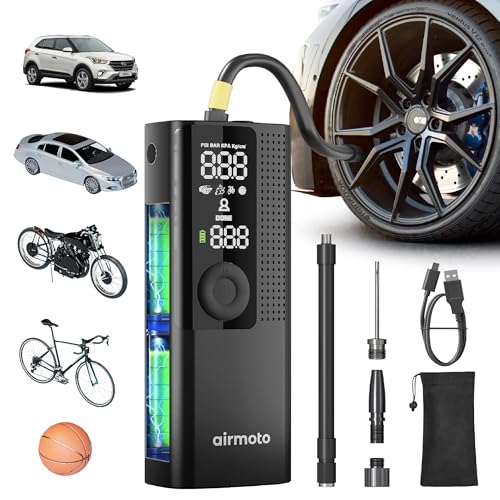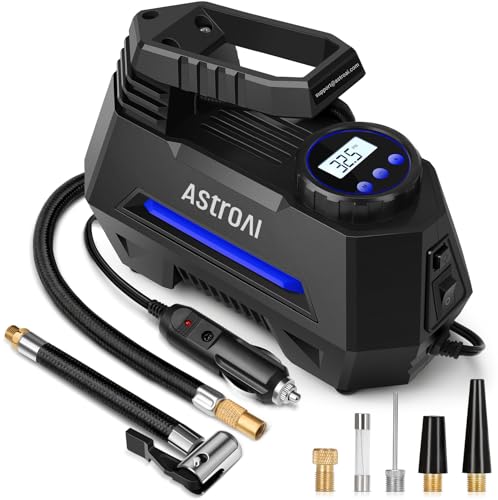The Ultimate Guide to Picking the Perfect Car Tire Inflator
A tire inflator, also known as an air compressor, is a device that pumps air into vehicle tires to maintain the proper air pressure. Ensuring your tires have adequate pressure is critical for safe driving and optimal tire performance.
Underinflated tires can lead to tire wear, reduced fuel economy, handling issues, and blowouts. Overinflated tires may negatively impact handling and braking as well. The correct pressure levels vary by vehicle make, model and tire type, so it’s important to consult your owner’s manual. An accurate tire pressure gauge and inflator allows you to precisely meet the recommended PSI (pounds per square inch).
Benefits of proper inflation include:
- Improved vehicle handling and braking
- Reduced risk of blowouts and flats
- Better fuel efficiency
- Extended tire life and tread wear
- Smoother ride and traction
- Avoidance of uneven tire wear
Regularly checking pressures with a tire gauge can alert you to a leak or puncture before it becomes dangerous. A portable inflator means you can conveniently fill tires anytime. This guide will walk you through choosing the best tire inflator for your needs.
Types of Tire Inflators
When it comes to selecting the right tire inflator for your needs, there are a few main types to consider:
Air Compressors
Air compressors are powerful stationary or portable units that connect to an outlet and provide a high volume of compressed air. They come in electric and gas-powered models. Stationary air compressors offer very high air pressure output and are ideal for automotive shops or garages. Portable air compressor units are still quite powerful, though not as much as stationary models. Portable air compressors need to be plugged into your car’s cigarette lighter or an outlet and rely on the vehicle’s battery or outlet for power.
The benefits of air compressors are their power and ability to inflate tires quickly. They can also handle higher pressure tires like those on trucks. The downsides are that stationary compressors aren’t portable, while portable models still require a power source and can be rather bulky.
Cordless Portable Inflators
Cordless portable inflators run on rechargeable batteries and offer the ultimate convenience for tire inflation on the go. There are no cords required so you can easily keep them in your trunk. These portable units are compact, lightweight and quick to get your tires aired up.
The advantage of cordless inflators is the convenience and portability. The tradeoff is that they don’t have as much power as air compressors, so are best suited for inflating car and light truck tires, not heavy duty tires requiring high pressure. They can also only run for so long on a single charge.
Cigarette Lighter Portable Inflators
These portable inflators plug into your vehicle’s 12V cigarette lighter or accessory power outlet. They are compact and convenient to store in your car, providing portable inflation capabilities without relying on battery power. Most can inflate a mid-sized car’s tire from flat to 30 PSI in under 10 minutes.
The benefit of cigarette lighter inflators is they offer solid performance while relying on your car’s power, so no concerns over battery life. The downside is you need to have the car running during use to power the inflator. They don’t work as well for larger tires or high pressure.
So in summary, air compressors offer power but less portability, cordless inflators provide convenience but run on batteries, and cigarette lighter models offer a balance of performance and portability while relying on your car’s power. Choose the type that best fits your specific needs and usage.
Key Features to Look For
When choosing a tire inflator, there are several key features to consider:
- Accuracy – A quality tire inflator should provide precise air pressure readings and have the ability to inflate tires to the proper PSI. Look for digital gauges that are easy to read. An accuracy of +/- 1 PSI is ideal.
- Durability – Since tire inflators are portable tools that may be carried in your vehicle and exposed to various weather conditions, durability is important. Look for sturdy, impact-resistant plastic casings. Metal or reinforced hoses will withstand wear and tear.
- Portability – Determine the size and weight that works best based on your needs. Smaller units easily fit inside a glovebox while larger inflators with more power may be stored in a trunk. If bringing a tire inflator hiking or camping, lightweight is ideal.
- Ease of Use – The inflator should be easy to operate, with clear buttons or dials and legible gauges. Models that automatically stop at a preset PSI take the guesswork out of proper inflation. An adequate hose length improves access to tires.
- Attachments – Nozzles that fit a variety of valves like presta, schrader, sports balls, etc. maximize versatility. Some inflators include power plugs or built-in lights for nighttime inflation needs.
- Power Source – Tire inflators run on battery, AC power, or a vehicle’s 12V outlet. Battery operated models offer the most portability while corded ones provide unlimited runtime. Consider your access to power when on the road or trail.
Determining Your Needs
When choosing the right tire inflator, it’s important to consider your specific needs and situation. Here are some key factors to think about:
Type of Vehicle
- What type of vehicle will you be inflating tires for – car, truck, SUV, bicycle, etc? The type and size of tires will impact the inflation power and features you need. For example, inflating large truck tires requires more power than smaller car tires.
- Will you need to inflate tires for multiple types of vehicles? Opt for a versatile inflator that can handle different tire sizes.
Frequency of Use
- How often will you need to use the inflator? For frequent needs, invest in a sturdy model built for durability and daily use. If it’s just for occasional use, a basic inflator will suffice.
- Do you need to inflate tires while on the go? A portable, cordless inflator may be ideal for mobility. Stationary inflators are fine if you’ll always be near a power source.
Budget
- Inflator prices range from $20 to $200 or more. Determine how much you’re willing to spend. High-end inflators offer faster inflation, more settings and durability but may not be necessary for basic needs.
- Consider long-term costs too – a more expensive but durable unit can save money over time versus replacing cheaper inflators that break frequently.
Taking the time to properly evaluate your vehicle needs, usage requirements and budget will help narrow down the many inflator options to find your ideal match. Test different models in person when possible and read reviews from other owners of your vehicle type. Making an informed decision now will ensure you choose the right tire inflator for your needs.
Top Recommendations
There are a few tire inflators that consistently rise to the top for their performance, features, and value. Here are my top picks:
Slime 40022 12-Volt Digital Tire Inflator
This versatile digital inflator from Slime can handle car, truck, and SUV tires. It plugs into your cigarette lighter and has an easy-to-read digital pressure gauge. The inflation hose is 2 feet long. This is a great all-around inflator for the average driver.
EPAuto 12V DC Portable Air Compressor Pump
This affordable inflator by EPAuto has an automatic shut off when it reaches the desired tire pressure. It works fast, inflating a midsize tire from 0 to 30 PSI in 5 minutes. The digital display is easy to read. It comes with additional nozzles for balls, pools, etc.
FORTEM Digital Tire Inflator for Car
FORTEM’s car tire inflator has an automatic stop feature when the target pressure is reached. It measures in PSI, KPA, BAR, or KG/CM2. The bright LED flashlight helps see when inflating at night. It comes with a carry bag.
JACO ElitePro Tire Inflator
This heavy duty tire inflator by JACO has a max PSI of 150. It has an automatic shut off when the desired pressure is reached. The advanced pressure dial is very accurate. It has a built-in bleeder valve and a 25 foot cord.
Tirewell 12V Tire Inflator
This cordless tire inflator by Tirewell runs on a rechargeable battery, so no cords needed! It’s great for emergencies and has a built-in LED flashlight. It automatically shuts off when reaching the preset tire pressure.
Proper Tire Inflation
Properly inflating your tires is critical for safety, fuel efficiency, and preventing tire wear. Here are some tips for keeping your tires inflated to the proper pressure:
- Check your tire pressure at least once a month and before any long trips. The correct pressure levels are listed in your owner’s manual and on a sticker inside the driver’s side door jamb. Use an accurate tire pressure gauge to check each tire when cold, before driving the vehicle.
- If a tire is low, add air until it reaches the recommended pressure. You can add air at most gas stations using the air pump. Go slowly and check the pressure frequently with your gauge to avoid overinflating.
- Don’t exceed the maximum pressure listed on the tire sidewall. Overinflation can cause tires to wear improperly and makes the ride stiff. It also increases the risk of damage from road hazards.
- Consider investing in a good at-home compressor that can air up a tire from flat to proper pressure within a few minutes. This allows you to check and fill as needed without going to the gas station.
- Rotate your tires every 5,000-8,000 miles to ensure even tread wear. Alignment issues or low pressure can cause uneven wear patterns.
- Check tire condition each time you inflate. Look for any cuts, gouges, bulges or tread issues that might indicate a problem.
Properly inflated tires will increase your safety on the road, improve fuel efficiency, and extend the life of your tires. Taking a few minutes each month to check and inflate as needed is time well spent.
Maintenance
Proper maintenance of your tire inflator will keep it in good working order and extend its lifespan. Here are some tips for maintenance:
Cleaning
- Wipe down the exterior of the inflator after each use to remove any dirt, dust or debris. Use a damp cloth with a small amount of mild detergent. Avoid using solvents or abrasives.
- Check the air filter regularly and clean or replace it as needed. A dirty filter can restrict airflow. Refer to the owner’s manual for filter cleaning and replacement instructions.
- Clean the air chuck by wiping it down with a clean cloth. Check for any obstructions in the nozzle and use compressed air to clear out any debris.
Storing
- Coil the power cord neatly and secure it with a twist tie or Velcro strap before storing. Don’t wrap the cord too tightly around the inflator.
- Store the inflator in a clean, dry location away from direct sunlight and extreme temperatures. Avoid storing it in the garage if exposing it to vehicle exhaust fumes.
- If storing for long periods, run the inflator briefly every few months to keep the internal parts lubricated.
Replacing Parts
- Replace the air filter periodically as specified in the owner’s manual. Using a dirty filter will reduce performance.
- Inspect hoses and power cords for cracks, leaks or damage. Replace any defective parts.
- Consider replacing the pressure gauge if readings become inaccurate. An inaccurate gauge can lead to improper tire pressure.
- Only use manufacturer recommended replacement parts to ensure proper operation and safety.
Safety Tips
When using a tire inflator, follow these safety tips:
- Always read and follow the manufacturer’s instructions. Don’t take shortcuts.
- Wear protective eyewear when inflating a tire. The force of air can propel debris towards your face.
- Point the inflator hose away from you when turning it on. The initial burst of air could spray items towards you.
- Keep children and pets at a safe distance. The noise and air pressure could startle them.
- Use tire inflator on flat, level ground with tire valve at 12 o’clock position. This prevents the tire from rolling or slipping.
- Avoid overinflating tires. Follow manufacturer’s recommended tire pressure not the maximum pressure listed on tire sidewall. Overinflation can cause tire to explode.
- Watch for leaks by spreading soapy water on tire valve and rim during inflation. Stop immediately if you see bubbles indicating a leak.
- Do not use a tire inflator continuously for more than 10 minutes. It can overheat. Allow 15 minute cool down between uses.
- Stop inflation immediately if you hear abnormal squeaking or air leaking sounds. Check for damage before continuing.
- Make sure to bleed pressure and disconnect hose after reaching proper inflation and before removing the inflator chuck.
- Store inflator properly in a clean, dry location out of direct sunlight when not in use.
Following basic safety measures will help ensure proper operation and prevent injuries when using a tire inflator. Check tires regularly and inflate them to recommended levels for best performance and safety.
Frequently Asked Questions
What PSI should I inflate my tires to?
The recommended PSI depends on your vehicle make and model, as well as the type of tires you have. Check your owner’s manual or the sticker inside the driver’s side door jamb for the manufacturer’s recommended tire pressure for your vehicle. Do not exceed the maximum PSI listed.
How often should I check my tire pressure?
You should check your tire pressure at least once a month and before any long trips. Tire pressure fluctuates with temperature changes, so it’s important to stay on top of it.
Why does my tire pressure keep going down?
If you have to refill a tire frequently, you likely have a very slow leak, known as a weeping tire. Causes include a nail or other puncture in the tread, a bad valve stem, or bead leakage. Have a professional inspect your tires to locate and seal the leak.
What is the best tire inflator to buy?
There is no single best tire inflator for everyone. Consider key factors like portability, power source, psi range, added features like lights or power outlets, and price. Determine your needs and look for inflators that fit those requirements. Top brands include Viair, Slime, Craftsman, Ryobi, and Dewalt.
How do I use a tire inflator properly?
First, remove the valve stem cap. Attach the inflator nozzle tightly and make sure the inflator is set to the desired psi. Turn it on and squeeze the trigger to add air. Periodically check the tire gauge until you reach the correct pressure. When finished, turn off the inflator and disconnect. Reinstall the valve stem cap and repeat for any other tires that need air.
Why does my inflator keep turning off before reaching the right psi?
If your inflator keeps automatically shutting off before the tire is fully inflated, it likely has an auto-shutoff feature to prevent overinflation. Allow the inflator to cool off for a few minutes before resuming. Make sure to check the psi periodically so you don’t exceed the max fill.
What do I do if my tire inflator isn’t working?
First, check that it’s plugged in or that the battery is charged. Try a different outlet. Verify the power switch is on. Make sure all connections are air tight. Check for clogs. Refer to the user manual for troubleshooting tips specific to your model. If problems persist, contact customer support or take it to a repair shop.
How can I prevent issues when using a tire inflator?
- Always follow manufacturer instructions and safety precautions.
- Check tires for leaks, punctures or other damage before inflation.
- Use tire pressure gauges for accurate readings.
- Avoid running inflators for more than 10 minutes continuously as they can overheat.
- Make sure valves and connections are properly secured before inflating.
- Stay nearby and monitor progress to prevent overinflation.
- Keep inflators clean and store properly when not in use.
What safety precautions should I take when inflating tires?
- Wear ANSI-approved safety goggles to protect your eyes.
- Do not overinflate tires beyond the recommended psi.
- Use a clip-on chuck with an in-line gauge and stand a safe distance back during inflation.
- Avoid kinks or bends in the air hose.
- Check tires and valves for damage first.
- Keep children and pets at least 30 feet away when inflating tires.
- Do not leave an inflator unattended while in use.
Conclusion
Choosing the right tire inflator for your needs is an important decision that requires some research and forethought. Here are some key points to summarize:
- Determine how you plan to use the inflator – at home, on the road, or both. This will help narrow down the type and features you need.
- Consider power source – compressed air tank, battery powered, or plug-in. Each has pros and cons to weigh.
- Look at inflation speed, accuracy, ease of use and portability if needed. Faster inflation and digital displays can be helpful.
- Make sure the inflator has features to prevent over-inflation. An automatic shut off is ideal.
- Purchase a kit that includes additional nozzles and accessories if you’ll use it for multiple tires/vehicles.
- Check reviews and warranties to find a quality and reliable brand.
- Invest in a sturdy, heavy-duty inflator if you’ll use it often. It’s worth spending more upfront.
- Follow proper operating guidelines for inflation and maintenance.
- Always put safety first and make sure tires are inflated to the vehicle’s recommended PSI.
In closing, take the time to assess your tire inflation needs so you choose the right solution. A good tire inflator is a worthwhile investment for vehicle safety and performance. With a quality inflator that suits your uses, you’ll be prepared to inflate tires quickly, accurately and safely for years to come.

